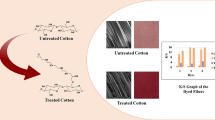Abstract
Simultaneous crosslinking and cationization of cotton cellulose were carried out by using two dialdehydes, glyoxal (GO) and glutaraldehyde (GA), along with choline chloride (ChCl). Two heating methods, conventional pad-dry-cure (PDC) and microwave irradiation, were investigated and compared. The results revealed that two aldehyde molecules reacted very differently in the presence of ChCl under two different heating methods. GO reacted predominantly with the cellulose molecule, stimulating the crosslinking reaction and consequently resulting in high wrinkle recovery angle (WRA) values regardless of the heating process. Contrarily, GA favored the reaction with ChCl, allowing high K/S values with acid dye under microwave irradiation. The crosslinked and cationized cotton cellulose was only obtained by treatment with GA and ChCl under the PDC process, resulting in high WRA and K/S values. Characteristics of the treated fabrics were also evaluated by Fourier transform infrared analysis, thermogravimetric analysis, scanning electron microscopy, water of imbibition, and tensile strength test. Additionally, the treatments with GA and ChCl also provided high antimicrobial properties of the cotton celluloses; thereby most bacteria reductions of the specimens were close or equal to 99.9 %. Therefore, economically viable yet ecofriendly crosslinking and cationization of cotton cellulose could be made by treatment with GA and ChCl.

















Similar content being viewed by others
References
AATCC Technical Manual, AATCC TM 66-2008 (2008) Wrinkle recovery of woven fabrics: recovery angle, vol 88. American Association of Textile Chemists and Colorists, Research Triangle Park, pp 113–116
ASTM Book of Standards (2013) ASTM D5035-11, standard test method for breaking strength and elongation of textile fabrics (strip test), vol 07.02. ASTM International, West Conshohocken, pp 235–241
Budimir A, Bischof Vukusic S, Flincec SG (2012) Study of antimicrobial properties of cotton medical textiles treated with citric acid and dried/cured by microwaves. Cellulose 19:289–296
Cho JY, Hong CJ, Choi HM (2013) Microwave-assisted glycolysis for PET with highly hydrophilic surface. Ind Eng Chem Res 52:2309–2315
Choi HM, Kim JH (1999) Characterization of cotton fabrics treated with glyoxal and glutaraldehyde. J Appl Polym Sci 73:2691–2699
Ferrero F, Periolatto M (2012) Functionalized fibrous materials for the removal of dyes. Clean Technol Environ Policy 14:487–494
Gorman SP, Scott EM, Russell AD (1980) Antimicrobial activity, uses and mechanism of action of glutaraldehyde. J Appl Bacteriol 48(2):161–190
Guo Y, Zhou J, Wang Y, Zhang L, Lin X (2010) An efficient transformation of cellulose into cellulose carbamates assisted by microwave irradiation. Cellulose 17:1115–1125
Hardy PM, Nicholls AC, Rydon HN (1969) The nature of glutaraldehyde in aqueous solution. J Chem Soc D 10:565–566
Katovic D, Bischof Vukusic S, Flincec GS, Kovacevic S, Schwarz I (2008) The effect of microwave drying on warp sizing. Text Res J 78(4):353–360
Kawahara J, Ohmori T, Ohkubo T, Hattori S, Kawamura M (1992) The structure of glutaraldehyde in aqueous solution determined by ultraviolet absorption and light scattering. Anal Biochem 201(1):94–98
Kim JY, Choi HM (2014) Cationization of periodate-oxidized cotton cellulose with choline chloride. Cellul Chem Technol 48(1–2):25–32
Ma W, Meng M, Zhang S, Ju B, Zhang M (2012) Application mechanism and performance of cationic native starch and cationic hydrolyzed starch in salt-free dyeing of reactive dyes. Appl Mech Mater 161:212–216
Marshall WE, Wartelle LH (2004) Anion exchange resin from soybean hulls. J Chem Technol Biotechnol 79:1286–1292
Migneault I, Dartiguenave C, Bertrand MJ, Waldron KC (2004) Glutaraldehyde: behavior in aqueous solution, reaction with proteins, and application to enzyme crosslinking. Biotechniques 37(5):790–796 and 798–802
Park JH, Oh KW, Choi HM (2013) Preparation and characterization of cotton fabrics with antibacterial properties treated by crosslinkable benzophenone derivative in choline chloride-based deep eutectic solvents. Cellulose 20:2101–2114
Ruijgrok JM, Boon ME, De Wijn JR (1990) The effect of heating by microwave irradiation and by conventional heating on the aldehyde concentration in aqueous glutaraldehyde solutions. Histochem J 22:389–393
Sharif S, Ahmad S, Izhar-ul-Haq MM (2007) Role of quaternary ammonium salts in improving the fastness properties of anionic dyes on cellulose fibres. Color Technol 123:8–17
Wang Y, Hsieh Y-L (2010) Aldehyde functionalized cellulose support for hydrogels. J Appl Polym Sci 118:2489–2495
Wartelle LH, Marshall WE (2005) Chromate ion adsorption by agricultural by-products modified with dimethyloldihydroxyethylene urea and choline chloride. Water Res 39:2869–2876
Whipple EB, Ruta M (1974) Structure of aqueous glutaldehyde. J Org Chem 39(12):1666–1668
Wine Y, Cohen-Hadar N, Freeman A, Frolow F (2007) Elucidation of the mechanism and end products of glutaraldehyde crosslinking reaction by X-ray structure analysis. Biotechnol Bioeng 98(3):711–718
Yoshioka SA, Goissis G (2008) Thermal and spectrophotometric studies of new crosslinking method for collagen matrix with glutaraldehyde acetals. J Mater Sci Mater Med 19(3):1215–1223
Yuan H, Hauser PJ (2014) Synthesis of a bi-functional cationic agent and its application in cotton dyeing. AATCC J Res 1(2):9–12
Zhang F, Chen Y, Lin H, Lu Y (2007) Synthesis of an amino-terminated hyperbranched polymer and its application in reactive dyeing on cotton as a salt-free dyeing auxiliary. Color Technol 123:351–357
Acknowledgments
This research was supported by the Basic Science Research Program through the National Research Foundation of Korea (NRF) funded by the Ministry of Education, Science and Technology (no. 2013-055716).
Author information
Authors and Affiliations
Corresponding authors
Rights and permissions
About this article
Cite this article
Park, J.H., Choi, HM. & Oh, K.W. Simultaneous crosslinking and cationization of cotton cellulose by using dialdehyde and choline chloride: comparison between the pad-dry-cure and microwave irradiation process. Cellulose 21, 3107–3119 (2014). https://doi.org/10.1007/s10570-014-0326-z
Received:
Accepted:
Published:
Issue Date:
DOI: https://doi.org/10.1007/s10570-014-0326-z




